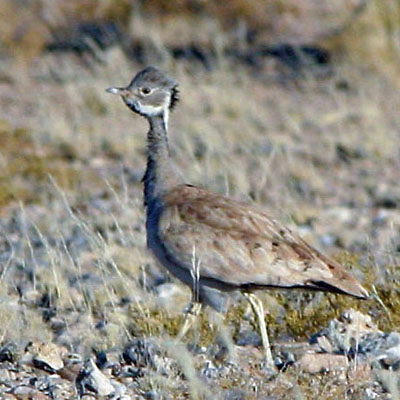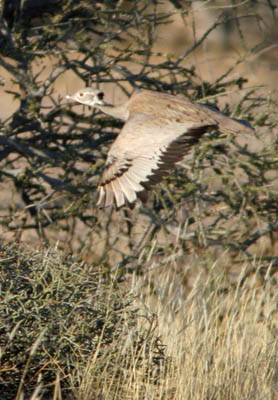
a web page by Don Roberson |
BUSTARDS Otididae |
|||
|
|||
I've always wanted to see "the big three:" Kori in Africa, Australian Ardeotis australis, and the endangered Great Indian Bustard A. nigriceps. It was satisfying to accomplish that goal in 2001. I have an old page, using digitized slides, about seeing the three big bustards, with a focus on the story of finding the most difficult one, the Great Indian. |
|||
|
|||
 |
|||
This is Ludwig's Bustard: a big, heavy (possibly young) male in a South African wildflower reserve (above), and a lighter, patterned female from Namibia. Full adult males have a completely black head. These are birds of open plains and scrub in desert or arid karoo habitat. There is seasonal movement in response to rain patterns. The species is currently listed as "endangered" due to declines in the South African populations, and concerns about collisions with power lines and wind-farms (Jenkins 2011). |
|||
The genus Neotis, which includes Ludwig's Bustard, has four species of medium-large bustards. Denham's Bustard (below left) — another one with a rufous neck stripe— occurs on isolated plains or open savanna in much of sub-Saharan Africa, but seems everywhere to be on the decline. The genus Otis — from which the family name arises — has the other large bustard: Great Bustard (below right, male in full display, in a nice shot by Graham Catley). Great Bustard is a resident in its patchy range in Europe (Spain to eastern Europe) but is migratory in its open plains habitat in Eurasia, all the way east to northeast China. It, too, is declining. The scientific name for Great Bustard is Otis tarda. According to Collar (1996), the "word bustard comes from the Latin avis and a lost Spanish word tarda, which does not mean 'slow' but is related to the English word 'tread,' and signifies walking; bustards are birds that walk, generally speaking, at a deliberate, measured pace, although they commonly stand motionless for periods at a time." Bustards are very much birds of open country. They never use trees; indeed, they lack a hind toe that could grasp such a perch. Except for those that migrate or undertake seasonal movements, bustards fly relatively little and in some seasons may go weeks without taking wing. All bustards are omnivorous, eating whatever is in local abundance, from insects and lizards to green shoots and flowerheads. |
|||
|
|||
|
|||
Currently, there are 26 species of bustards in 9 genera, and has been comparatively stable since Pitra et al. (2002). The remaining species are medium to smallish in size. Despite the striking underparts or wing patches of some males, all the bustards are patterned above with beautiful camouflage washes or barring in browns and buff to protect them from aerial predators like hawks and falcons. Females are especially cryptic in their grassland habitat. Shown above are two African species that illustrate this point: a female Hartlaub's Bustard (above left), in long grassland in east Africa, and a female White-quilled Bustard (above right), in arid semi-desert in Namibia. Most species have extraordinary courtship displays that combine contortions of plumage with vertical hops, short flights, bowing, or head-bobbing. Courting males are particularly gaudy — as shown above in Kori and Great Bustards — but also in smaller species. Some species indulge in aerial displays. The male White-bellied Bustard (below) is one of the most widely distributed bustards in Africa, although its range is patchy. There are five subspecies. I've seen it multiple times in different countries, but I'd never seen this apparent courtship display before. According to Kirwan et al. (2021), "In courtship, male approaches female with outstretched neck, puffed-out throat feathers, and head and neck feathers raised to form a ruff; at least in captivity, male may feed female in courtship." I just looked that up on-line — and was shocked to see that the photo used by Kirwan et al. (2021) to accompany that text was, in fact, my shot that I post here: |
|||
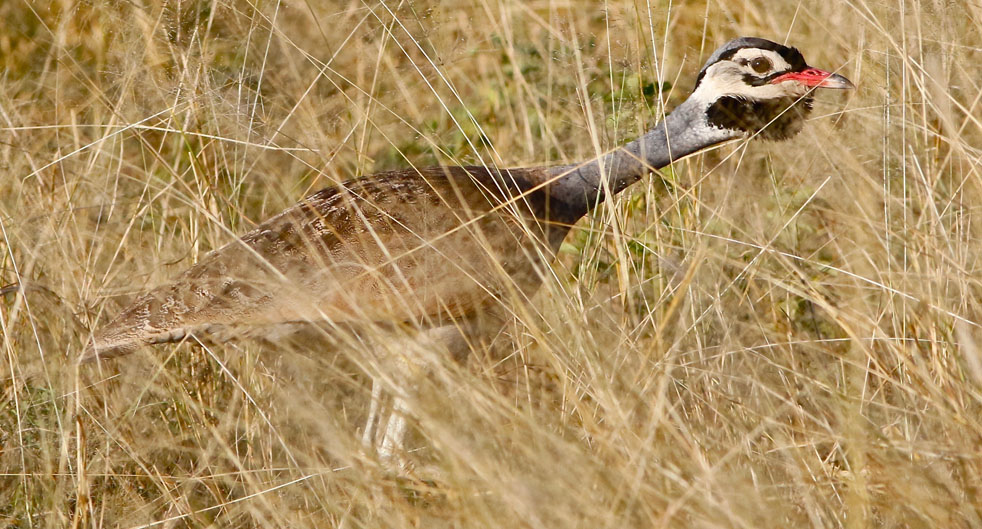 |
|||
|
|||
Black Bustard is a South Africa endemic restricted to the south and western Cape. White-quilled Bustard has a larger range to the north that includes much of Namibia and Botswana, where it inhabits Nama Karoo, Kalahari sandveld, dry grassland, open savanna, and grass dunes, and it apparently nests year-round (Collar 1996). Both species are polygynous. To attract females, males display with legs dangling while in flight.
|
|||
 |
|||
|
|||
Although Africa has most of the bustards, there are two very interesting Indian species known as floricans. The Lesser Florican Sypheotides indica breeds with the monsoon on the central plateau grasslands of the Indian subcontinent, and then moves to the west for winter. It is now highly endangered, as is the Bengal Florican Houbaropsis bengalensis. This latter is an impressive bird that exists only in fragmentary wet grasslands on the border of Nepal and India, and in a virtually unknown tiny population is in Cambodia and adjacent Vietnam. Searching out the Bengal Florican was the primary bird target on a visit to Kaziranga National Park in Assam. We were fortunate to find two males in the habitat for Bengal Florican (shown below; with inset painting by Norman Arlott of the bird itself). This habitat is on Debeswari Island in the Brahmaputra River. The island floods entirely during the autumn monsoon, and dries out every spring and summer. Thus the island remains as wet grassland, rather than forest (you can see forest on the far side of the river in the photo above). This seasonally flooded grassland habitat is becoming increasingly scarce and now exists only in isolated patches, causing much concern for the future existence of the floricans — and other species that rely solely on this specialized habitat. |
|||
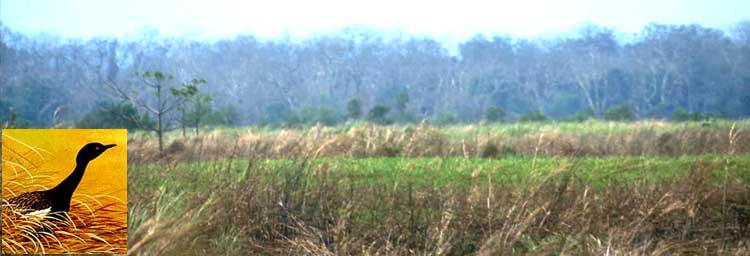 |
|||
Photos: The 3 photos of a displaying Kori Bustard Ardeotis kori were taken on the plains in Ngorongoro Crater, n. Tanzania, on 11 June 2018. The upper photo of Ludwig's Bustard Neotis ludwigii was at Nieuwoudtville Wildflower Reserve, Northern Cape, South Africa, on 6 July 2005; the female was in Etosha NP, Namibia, on 19 July 2005. The Denham's Bustard Neotis denhami was in Masai Mara NP, Kenya, on 23 Nov 1981. Graham Catley photographed the displaying Great Bustard Otis tarda was in Spain in summer 2003. The female Hartlaub's Bustard Lissotis hartlaubii was in Ngorongoro Crater, Tanzania, on 8 Aug 2002. The female White-quilled Bustard Eupodotis afraoides was in Etosha NP, Namibia, on 21 July 2005.. The displaying male White-bellied Bustard Eupodotis senegalensis was in Tarangire NP, Tanzania, on 8 June 2018. The two photos of a male White-quilled Bustard Eupodotis afraoides were taken in Etosha NP, Namibia, on 21 July 2005. The male Black Bustard Eupodotis afra was in flight in West Coast NP, South Africa, on 5 July 2005. The displaying male Buff-crested Bustard Eupodotis gindiana was in Tarangire NP, Tanzania, on 8 June 2018. The two photos of a male Rüppell's Bustard Eupodotis rueppelii were taken at Grosse Spitzkoppe Nature Reserve, Namibia, on 17 July 2005. The photo of the habitat is which we saw Bengal Florican Houbaropsis bengalensis was taken in April 2002 on Debeswari Island in the Brahmaputra River, Kaziranga NP, Assam, India, just after seeing one walking in right center (it disappeared before I could get the camera out .... don't you just hate that?). The inset painting is by Norman Arlott from Rare Birds of the World (1988) by Guy Mountfort (Collins/ICBP). All photos © Don Roberson, except for the Great Bustard attributed to © Graham Catley, used with permission; all rights reserved. Bibliographic note: There is no "family book" of which I'm aware, but an excellent introduction to the family, with a set a very impressive photos, is in Collar (1996). As always with African species, a very useful entrée into those birds is in Urban, Fry & Keith (1986). Literature cited:
|
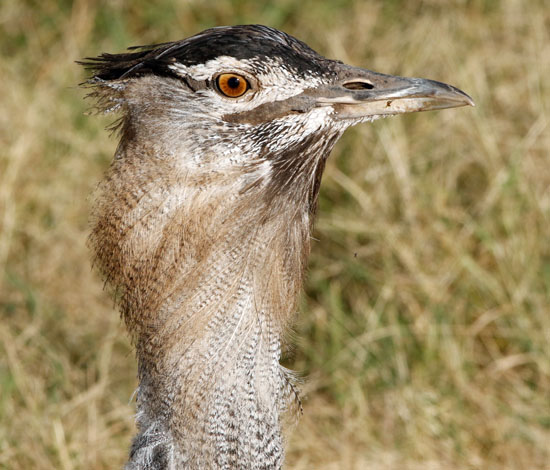 The bustards, family Otididae, are a distinctive Old World group that diverged from cranes 70 million years ago. Some 26 species inhabit grassland or semi-deserts in Africa and Asia; a final species lives in grasslands of Australasia. The largest of them all is the Kori Bustard (left & below) of east and southern Africa. Males (like this one) stand nearly four feet tall and can weigh up to 42 pounds (19 kg), making it among the heaviest flying birds on earth (Great Bustard is also very heavy). Females are about 2/3 the height and 1/3 the weight of males in genus Ardeotis. Male Kori Bustards give an impressive neck-ruffling display while giving a drum-like booming, as well as a "balloon-type" display in which some of the neck is expanded and others constricted, producing an outrageous "hourglass-shaped" white puffball (photos below).
The bustards, family Otididae, are a distinctive Old World group that diverged from cranes 70 million years ago. Some 26 species inhabit grassland or semi-deserts in Africa and Asia; a final species lives in grasslands of Australasia. The largest of them all is the Kori Bustard (left & below) of east and southern Africa. Males (like this one) stand nearly four feet tall and can weigh up to 42 pounds (19 kg), making it among the heaviest flying birds on earth (Great Bustard is also very heavy). Females are about 2/3 the height and 1/3 the weight of males in genus Ardeotis. Male Kori Bustards give an impressive neck-ruffling display while giving a drum-like booming, as well as a "balloon-type" display in which some of the neck is expanded and others constricted, producing an outrageous "hourglass-shaped" white puffball (photos below). 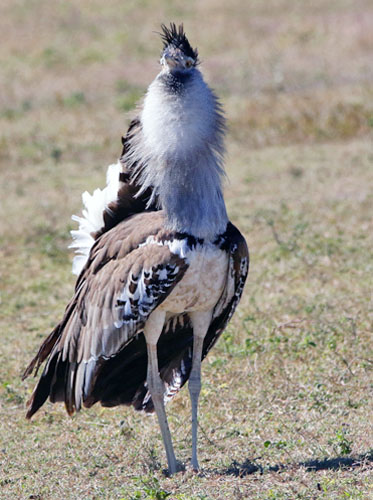
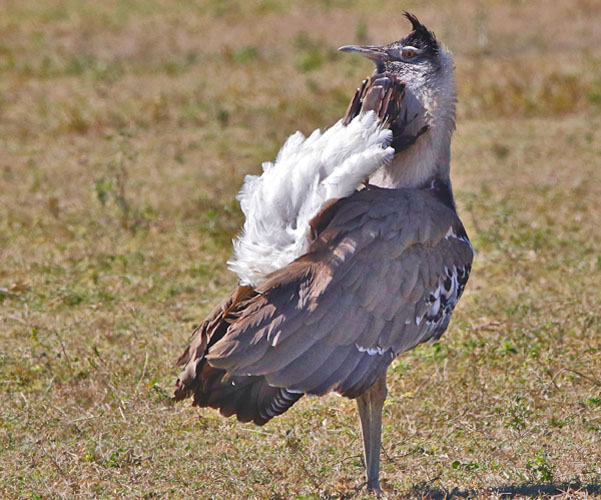
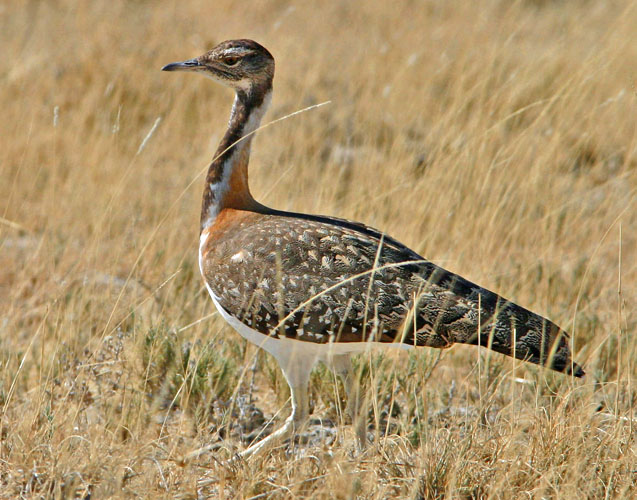 Most of the remaining species of bustards are half the size of the big bruisers, and some are even smaller than that. All, however, retain the distinctive bustard shape, and molecular evidence affirms they are a homogeneous group (Collar 1996). Bustards apparently arose in Africa, and 22 species occur there now, 16 of which are purely Afrotropical. Some of these are also quite large, beautiful, and impressive. Quite a number are also now local and scarce.
Most of the remaining species of bustards are half the size of the big bruisers, and some are even smaller than that. All, however, retain the distinctive bustard shape, and molecular evidence affirms they are a homogeneous group (Collar 1996). Bustards apparently arose in Africa, and 22 species occur there now, 16 of which are purely Afrotropical. Some of these are also quite large, beautiful, and impressive. Quite a number are also now local and scarce.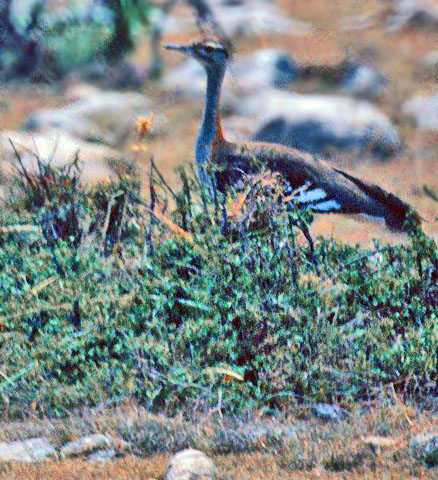
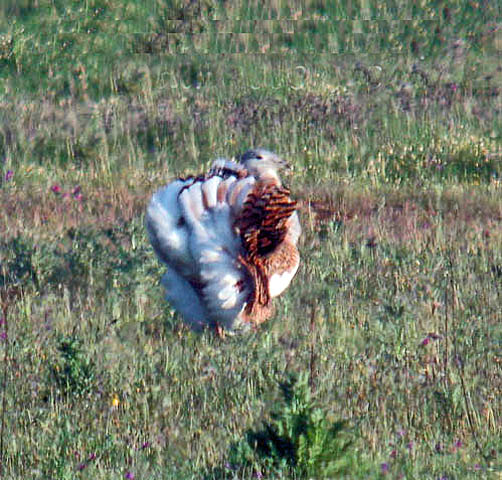
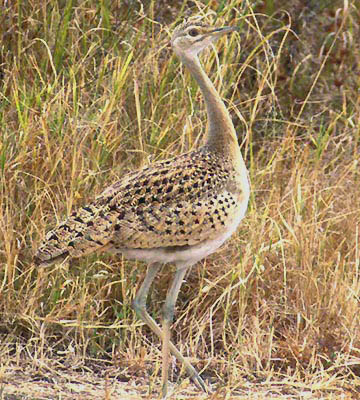

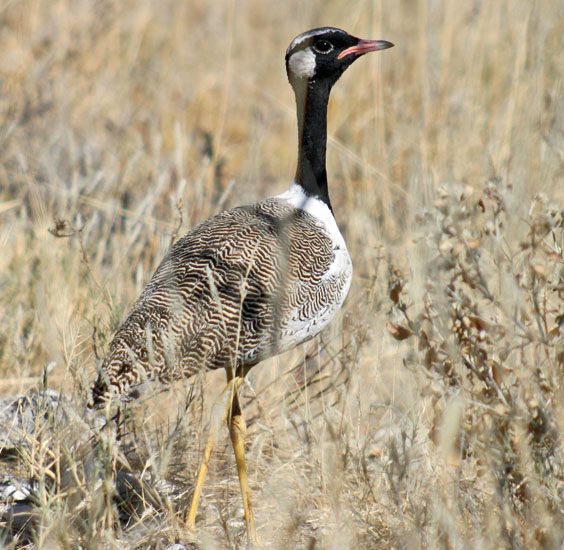
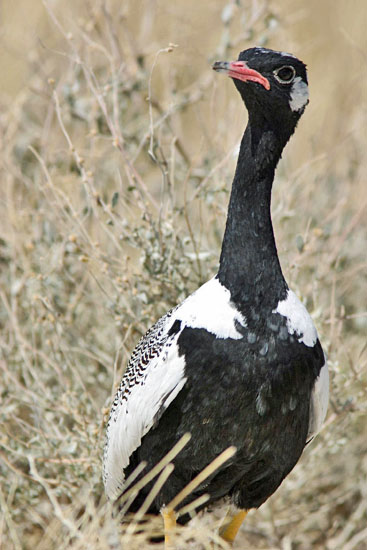
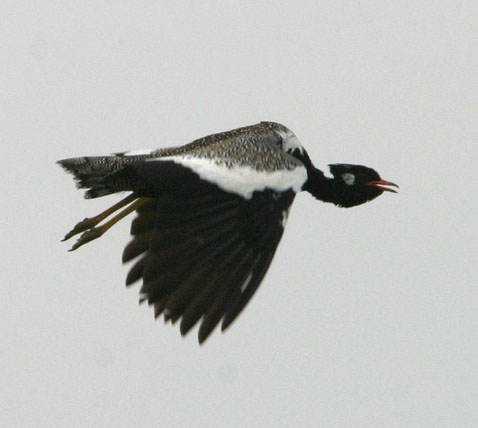 Two southern African species have extensively black underparts, producing a very striking pattern as on this male White-quilled Bustard (also known as "Northern Black Korhaan;" both photos of same male above), and on Black Bustard (also known as "Southern Black Korhaan," shown in flight, left). The two species are very similar, used to be their own genus ["Afrotis"], and have large white patches on their upperwing covers. They differ primarily in the extensive white on the primaries on male White-quilled in flight. South African observers and field guides (e.g., Sinclair et al. 1993) use the Afrikaans name "Korhaan" (from Dutch) as the "English" name for all eight of the small Eupodotis bustards that occur in southern Africa.
Two southern African species have extensively black underparts, producing a very striking pattern as on this male White-quilled Bustard (also known as "Northern Black Korhaan;" both photos of same male above), and on Black Bustard (also known as "Southern Black Korhaan," shown in flight, left). The two species are very similar, used to be their own genus ["Afrotis"], and have large white patches on their upperwing covers. They differ primarily in the extensive white on the primaries on male White-quilled in flight. South African observers and field guides (e.g., Sinclair et al. 1993) use the Afrikaans name "Korhaan" (from Dutch) as the "English" name for all eight of the small Eupodotis bustards that occur in southern Africa. 